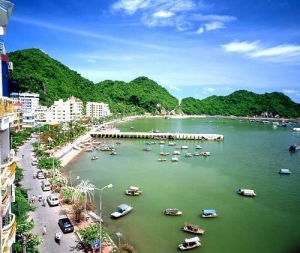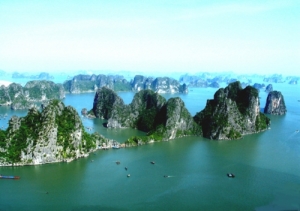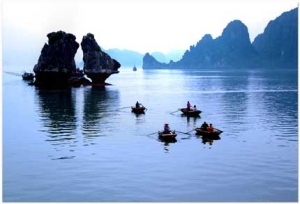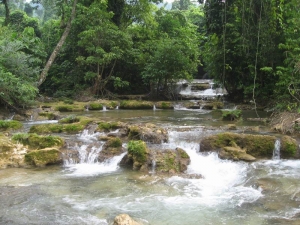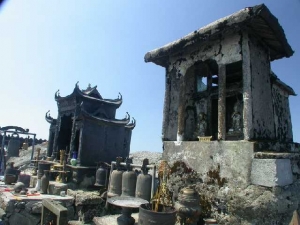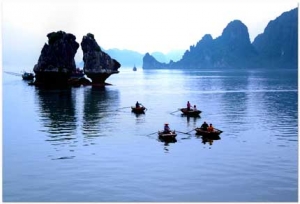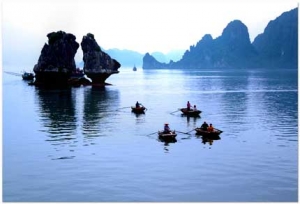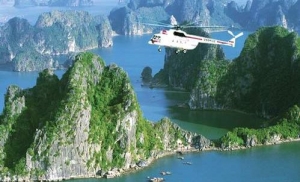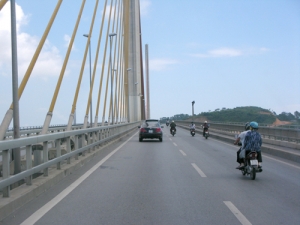
Asia Pacific Travel Team
Tuan Chau island - A New wonderful island
Ha Long, one of the World Heritages, comprises thousands of big and small islands. Each one has its own characteristic with various caves: Sung Sot Cave,Thien Cung Cave, Trinh Nu Cave. Tuan Chau Island is the only soil island of all. It is not only a place having beautiful natural surroundings: pine trees, lakes, beautiful beach…but also where President Ho Chi Minh chose to be the relax place of other State officials' and his when they came here in 1959.
On the total area of 400 ha, Tuan Chau has the population of 1500. As planned, the total area of Tuan Chau will be widen to 675 ha. It enjoys the advantage of having both road and river transportations. It is about 18 km away from National Highway No.1. This route is an important blood vessel of the robust Hanoi – Hai Phong – Quang Ninh economic triangle. It takes about 3 hours from Mong Cai ( 2 hours by boat) and 1 hour from Hai Phong.

Tuan Chau island’s name is the combination between ‘linh tuan’ (the patrolman) and ‘tri chau’ (district chief) because in the feudal time, the royal army set up a guard station here to patrol and defend the borderland. Prior to 1999, the island's residents suffered from a very modest living standard.There was no power network and no clean water. Roads were only trails and there was no mechanical means of transportation. Tuan Chau was a very poor town where fishing with very rudimentary tools is the only means of living.
The first project of great significance was to link Tuan Chau and the National Highway No18 by building a road. The work was officially started on February 28th, 1998. All company staff had to overcome numerous hardships to achieve this difficult task, which translated people’s dream into reality.
 Dolphin & Seal Club
Dolphin & Seal Club
Tuan Chau has become well- known to both international and domestic tourists as an attractive destination with:
- a dolphin&seal club
- a circus
- a crocodile club
- an (artificial) beach with 4 km long.
- a Vietnamese culinary area
- a hotel and resort area of 5-star standard (200 rooms)
- a water recreation park with activities such as motor racing, canoeing, parachuting, water skiing, etc.
- Ha Long Bay sight- seeing services by canoe, boat, helicopter.
- a high tech water fountain with music playing, laser lighting and film projecting on water screens.
Ha Long Bay - A New Wonder of the World
Situated in the North-East region of Vietnam, Halong Bay is a bay in the Gulf of Tonkin comprised of regions of Halong City, the township of Cam Pha, and a part of the island district of Van Don. Halong Bay borders Cat Ba Island in the southwest, the East Sea in the east, and the mainland, creating a 120 km coastline.
Halong Bay is made up of 1,969 islands of various sizes, 989 of which have been given names. There are two kinds of islands, limestone and schist, which are concentrated in two main zones: the southeast (belonging to Bai Tu Long Bay), and the southwest (belonging to Halong Bay). This densely concentrated zone of stone islands, world famous for its spectacular scenery of grottoes and caves, forms the central zone of Halong Bay, which has been named a UNESCO World Heritage Site.
The bay itself has an area of 43,400 ha, consists of 775 islands, and forms a triangle with the island of Dau Go (Driftwood Grotto) to the west, the lake of Ba Ham (Three Shelter Lake) to the south, and the island of Cong Tay to the east.
Viewed from above, Halong Bay resembles a geographic work of art. While exploring the bay, you feel lost in a legendary world of stone islands. There is Man's Head Island, which resembles a man standing and looking towards the mainland. Dragon Island looks like a dragon hovering above the turquoise water. La Vong Island resembles an old man fishing. There are also the islands of the Sail, the Pair of Roosters, and the Incense Burner, which all astonishingly resemble their namesakes. The forms of the islands change depending on the angle of the light and from where the islands are viewed. At the core of the islands, there are wonderful caves and grottoes, such as Thien Cung (Heavenly Residence Grotto), Dau Go (Driftwood Grotto), Sung Sot (Surprise Grotto), and Tam Cung (Three Palace Grotto).
Halong Bay has many links to the history of Vietnam. For example, there are such famous geographical sites as Van Don (site of an ancient commercial port), Poem Mountain (with engravings of many poems about emperors and other famous historical figures), and Bach Dang River (the location of two fierce naval battles fought against foreign aggressors).
It has been proven by scientists that Halong was one of the first cradles of human existence in the area at such archeological sites as Dong Mang, Xich Tho, Soi Nhu, and Thoi Gieng. It is also a region of highly-concentrated biological diversity with many ecosystems of salt water-flooded forests, coral reefs, and tropical forests featuring thousands of species of animal and plant life.
With all this in mind, the 18th meeting of the Committee of the World Heritages of UNESCO (in Thailand on December 17th, 1994), officially recognized Halong Bay as a natural heritage site of worldwide importance. Nearly, Ha Long Bay was voted to be a new wonder of the world.
I. Grottoes
Dau Go (Driftwood) Grotto
Dau Go Grotto is found on Driftwood Island, formerly known as Canh Doc Island. The name Driftwood Grotto comes from the popular story of the resistance war against the Nguyen Mong aggressors. In a decisive battle, Tran Hung Dao was given an order to prepare many ironwood stakes to be planted on the riverbed of the Bach Dang River. The remaining wooden pieces were found in the grotto and, as a result, the grotto was given its present name. The entrance is reached via 90 steps up the island. The grotto is divided into three main parts. In the first chamber, many forms can be seen in the rock, depending on the imagination of the observer. In the middle of the chamber, on the top of the pillar, there appears to be a monk draped in a long, dark cloak, with his right hand clasping a cane. Moving into the second chamber, visitors pass through a narrow "door", naturally formed through erosion. The light here is mysterious, and new images appear in the stone. At the end of the grotto is a well of clear water surrounded by four ancient walls.

In this grotto, there remains an engraved stone stele singing the praises of Halong Bay ordered by Emperor Khai Dinh when he came to visit the grotto in 1917. Dau Go is 40 minutes from Bai Chay. Admission is 15,000 VND per person, 5,000 VND for children under 15, and children under 6 are free.
Trinh Nu (Virgin) Grotto-Trong (Male) Grotto
The Virgin Grotto is situated in the island range of Bo Hon, in the system comprised of the Surprise Grotto, Dong Tien Lake, and Luon Grotto. The grotto is 15 km south of Bai Chay Beach. For some fishermen, the Virgin Grotto is home, while for young lovers it is a popular romantic rendezvous site.
According to legend, there once was a beautiful fisherman's daughter, whose family was so poor that they were in service of the rich administrator of the fishing zone, who forced the family to give him their daughter as a concubine. However, the fisherman’s daughter already had a lover and refused to marry the administrator. The administrator got angry and exiled her to a wild island where she suffered from hunger and exhaustion. One frightful night she turned to stone. On this same night, her lover, knowing of her danger, rowed his boat in search of her. However, a tempest destroyed his boat, and he floated to a nearby island. In a flash of lightening, he saw his lover in the distance, but his calls were driven away by the wind. In his final exhaustion, he also turned to stone (today’s Male Grotto).

When visiting the Virgin Grotto, you can still see the petrified girl with her long hair hanging down and eyes looking towards the mainland. Opposite the Virgin Grotto, the Male Grotto is still home to the lover whose his face is turned towards his mate. At times, his passionate calls and blows against the walls of the grotto can still be heard.
Thien Cung (Heavenly Palace) Grotto
This recently discovered grotto is one of the most beautiful in Halong Bay. Thien Cung is situated on the southwest side of the bay, 4 km from the wharf outside of Halong City. It is located in a small range of islands that resemble a throne embracing two superb grottoes at its core. The way to Thien Cung is perilous, covered on both sides by thick forest. After entering a narrow gate, the magnificent, 130 m long grotto opens up.
According to legend, a beautiful young lady named May (cloud) caught the eye of the Dragon Prince and he fell in love with her. They were betrothed and got married in the very center of the grotto. All of the scenes of their wedding, which lasted for seven days and seven nights, have been seemingly fossilized in the grotto.

In the center, there are four large pillars supporting the "roof of heaven". From the base to the top, many strange images seem to exist in the stone, including birds, fish, flowers and even scenes of human life. On the north wall of the grotto, a group of fairies seems to be singing and dancing in honor of the wedding. Under the immeasurably high roof, stalactites form a natural stone curtain. There is also the sound of a beating drum made by the wind blowing through the stone.
In the last chamber of the grotto, a natural gushing stream of water babbles throughout the year. Here there are three small ponds of clear water. One path meanders out of the grotto.
Quang Hanh Grotto
Located 9 km west of Cam Pha, Quang Hanh Grotto is the longest grotto in Halong Bay. It is 1,300 m long, and stretches throughout the stone mountain of Quang Hanh. The French named it "Le Tunnel," or Tunnel Grotto.
Quang Hanh Grotto is accessible by either boat or car, but the entrance only appears when the tide is out. Ba Co Shrine (shrine of three girls) is in the grotto beside a smooth stone block. Legend tells that three girls, who were once journeying on the sea, came to the grotto to take shelter from the rain. They were so engrossed with the beauty of the grotto, that they did not notice the rising tide. They drowned, only to become water goddesses.
Quang Hanh Grotto is extremely beautiful. A small boat will take you through the stone passageway by flashlight, casting magical colors on the hanging stalactites.
II. Islands
Bai Tho Mountain (Poem Mountain)
Bai Tho Mountain is 106 m high. It runs along the coast, half on land and half in the sea. Sailing in the bay, one or two hundred meters from the mountain, one can see a poem carved on a flat stone cliff.
In 1468, Emperor Le Thanh Tong, who was also a poet, made an inspection tour of the North-East region. He stopped at the foot of the mountain, and inspired by the magnificent beauty of his surroundings, he wrote a poem. Later, he had the poem engraved on the wall of the mountain. It is very interesting to climb the mountain and enjoy the panoramic view of the bay.
Tuan Chau Islet
Situated 3 km west of Dao Go Islet, Tuan Chau Islet has an area of 300 ha. On the islet, there is a very simple bamboo house built by the inhabitants of Quang Ninh for Uncle Ho to rest after visiting Halong Bay. The house is now carefully preserved by the locals.
III. Beaches
Bai Chay
Bai Chay is a resort located along the coast of Halong Bay. This is a windward ocean resort which has a year round average temperature of 20oC (68oF).
Bai Chay is a low gently sloping range of hills that runs along the sea for more than 2 km. Blended in among the pine trees are large hotels and small villas with distinguished architectural styles. Traveling down the asphalt road along the coast, visitors see long white stretches of sand and green rows of Casuarina trees, tucked under which are small family-run restaurants. After swimming at the beach, tourists can enjoy cold drinks and cool off in the breeze that sweeps in from the sea.
Ha Long Bay – the nature world wonder
Halong Bay is located in the Northeast of Vietnam, belonging to Ha Long city, Quang Ninh Province, in the Gulf of Tonkin. On the world map, it has borders to China in the North and adjacent to the East Sea in the East .
The Bay has a medium size of 1,553 square kilometers. It is accomodation of many fishing communities, including the 4 communes of Cua Van, Cong Tau, Vong Vieng and Ba Hang with a population of more than 1,600 people. The residents live on floating houses and boats, making their own lives by fishing and aquaculture.
The bay is a sea islands in tropical wet with 2 seasons: hot and moist summer, dry and cold winter. Average temperature is from 15°C- 25°C. Annual rainfall is between 2,000mm and 2,200mm. Halong Bay has the typical diurnal tide system (tide amplitude ranges from 3.5-4m). The salinity is from 31 to 34.5MT in dry season and lower in rainy season.
Historical name
Literally, “Ha Long” means "Bay of Descending Dragons." Before the 19th century, this name was not recorded in any document or archive. In this term, there is a mysteriously legendary tale as follows
“Long ago, in the first founding days, the Viet people were attacked by foreign aggressors. The Jade Emperor sent the Mother Dragon and her band of Child Dragons to help the Viet people fight the invaders. While the enemy vessels were launching massive attacks against the mainland, the dragons descended in flocks from the sky. They spat out innumerable pearls which changed into jade stone islands the moment they touched the water. These islands linked together to form firm citadels that checked the enemy’s advance and smashed their vessels to pieces. After the invaders were driven out, Mother Dragon and her Child Dragons did not return to Heaven but stayed on earth, right at the place where the battle occurred. The spot where the Mother Dragon landed was Ha Long, and where the Child Dragons came down was Bai Tu Long. The place where their tails violently wagged was called Long Vi, the today’s Tra Co Peninsula with its soft sandy beach stretching a series of kilometers.”
Gifted Beauty & top sightseeings
In 1962, the Ministry of Culture and Information classified Halong Bay as a National Landscape Site, covering an area of 1,553 km2 with 1,969 islands. Halong Bay has been recognized twice by UNESCO as a World Heritage Area for its universal values of landscape, geology and geomorphology, respectively in 1994 and 2000, an area of 434 sq. km. including 775 islands.
The dense cluster of 1,969 limestone monolithic islands within the bay is topped with thick jungle vegetation, which rise spectacularly from the ocean. Most of the islands were formed over 500 million years ago, and massed in the Southeast and Southwest. Those in the Southeast have an average height of 50-200m, covering lots of flora. Several of the islands are hollow, with enormous caves. Hang Đầu Gỗ (Wooden stakes Cave) is the largest grotto in the Ha Long area. French tourists visited in the late 19th century, and named the cave Grotte des Merveilles. Its three large chambers contain large numerous stalactites and stalagmites (as well as 19th century French graffiti). There are two bigger islands, Tuan Chau and Cat Ba, that have permanent inhabitants. Both of them have tourist facilities, including hotels and beaches. There are a number of wonderful beaches on the smaller islands. The others are Bai Chay, Ti Top, Minh Chau, Quan Lan and so forth.
Viewed from above, Ha Long Bay looks like an extremely vivid huge drawing, and sailing beneath the bay is like leisuring in between a huge valey on water. Ha Long bay is exactly a wonderfully skillful masterpiece of Nature that turns thousands of dumb soulless stone islands into fantastic sculptural and artistic works of various graceful shapes, both familiar and strange to human beings. Thousands of islands emerging in the fanciful waves look strong and magnificent but also mild and vivid. Amidst these islands tourists may feel as if they were astrayed in a petrified legendary world. The names given to the islands were based on their shapes and forms, such as, Human head Island, Sail island, Fighting cocks islands… Inside the stone islands are various breath-taking caves like Thien Cung, Dau Go, Sung Sot, and others. These are really magnificent palace of many huge stalactites hanging poised in mid air and stalagmites growing majestically upwards. Ha Long’s sea is always the same, blue, smooth and still.
What is more, the bay has its own seasoned beauty. In Spring, buds of trees burst on limestone islands. In Summer, it is cool and clean with many sparkling sun rays reflecting from the sea’s surface. In Autumn, especially at night, moonlight illuminates the mountains, making them like gold, inlaid into the earth. In Winter, with pervasive frost, Ha Long is glamorous as “a floating flower basket on smooth wave” (by writer Nguyen Tuan). All of them, stone, water and sky, make the Aesthetic value of Ha Long Bay.
The Bay’s Geological value is evaluated in two ways: by the history of its formation and its karst geomorphology. It is also home to the ancient Viet people beginning from 7,000 to 18,000 years ago, Ha Long’s Cultural − Historical value. Besides, Bio-diversity is an important natural resource, to be well-conserved so as to maintain the ecological balance of the whole region.
Ha Long Bay is undoubtedly not only a national but also a world nature, a magnificient work of Natural Creator. People who are admirers of natural beauty should stand up, pack their luggages, and right away pick up a flight to Ha Long, or else they will soon feel regretful!
Visit Mo Waterfall - Tuyen Quang in Vietnam Tourism
Mo Waterfall (or Thac Mo), which is located amid the Na Hang Natural Reserve (Na Hang District), is a wonderful eco-tourism destination of Tuyen Quang Province. It welcomes tourists in Vietnam travel, especially those who like adventures.
It is convenient to go to the waterfall. One can hear the noise of water pouring far from above. The closer visitors draw to the waterfall, the cooler they feel. It seems as if tourists in Vietnam travel were in a fairy land when they stand in front of the waterfall. Its water pours into the lake lying at the foot of the mountain. Tourists can take a small boat to reach the waterfall. When boating, they can relax and admire the picturesque setting around it.
Mo waterfall with the silver hues is composed of 3 layers. To reach the second layer, tourists have to climb up 100m by a rope ladder. At the foot of the second layer, there is a small and pure lake. The water flows slowly through the green moss-covered rocks, which look like a velvet rug. Keeping them climbing, tourists will reach the third layer. Water pours very strongly. The coolness of water seems to drive back the exhaustion of tourists, and to bring about a new feeling for them when they stand at the top to have a panoramic view of Na Hang Town, which is surrounded by 99 mountains. They can walk into the primitive forest to discover wonderful things. The sounds of the waterfall, birds and gibbons, and silver light going through the thick layers will make tourists feel as if they were in the prehistoric time.

Mo Waterfall - Tuyen Quang
If you are in or plan to visit Tuyen Quang in Vietnam tourism, you should once visit Mo Waterfall where you will see the imposing landscape with the caves, which have beautiful stalactites and stalagmites.
Tra Co Beach - truly paradisaical beach for tourists in Vietnam Tourism
Based at the first point of the S-shaped Vietnam, Tra Co beach, one of the most beautiful beaches, is an important stop-over when tourists arrive in Vietnam from the north.
Briefings
Tra Co beach is located in the Northeastern extreme of the “S-shaped Vietnam”, in Quang Ninh province. It is by the border with China, and around 8 kilometers from Mong Cai mountainous town and some 170 kilometers far away from Ha Long. With its advantages in terms of location, the beach is the destination of a number of travelers, especially those who come from China.
To the west, the province borders an extended forest and mountainous region. To the east, it is adjacent to the Gulf of Tonkin. It features a meandering coastline, numerous estuaries and tidal flats, and more than 2,000 large and small islands. Of which 1,030 have been named. The local annual temperature is around 22.7oC with two main seasons (Hot and Cold). The best time for swimming is summer season from April to September.
How to get there?
From Hanoi, going there by bus is a bit tired because of a long and uneven way of about 300km, and a long time of 7 hours. However, it is worth that you can enjoy the scenes of the Red river delta and will be surprised at different natural beauties from time to time and from plain to mountainous area.
Getting there by marine seems to be much easier and faster. After visiting Ha Long bay or Cat Ba island, we can take an express boat and reach to the beach after about two hours. By this way, you can also have a chance of enjoying the feelings of floating on the sea.
Why should you spend time here?
A fine and fresh sea environment
 Tra Co Beach
Tra Co Beach
Tra Co is considered one of “the most lyrical beaches in Vietnam” with a wide and plain beach, white and smooth sand, and blue sea water all the year round. The beach is about 15 kilometers long, on the edge of Tra Co peninsula, which was created by waves and flows. As a result, it covers some 3-4m sand-banks. Just nearby you can see a shadowed casuarinas forest, used to protect the inner village from hurricanes and the sand from erosion. It is neighboured to an original eco-system of mangrove forest is the zone lung. Known as one of the most beautiful beach in Vietnam, Tra Co is occasionally put in comparison with Nha Trang beach. Accordingly, if Nha Trang is as beautiful as a modern girl, Tra Co is a coyly rural girl since it has not yet been much exploited for tourism. Tra Co beach is much far from the city, industrial zone and harbour, which make it possess a cool and pure air, and a quiet and pristine environment.
A place of easy-to-buy seafood
If you would like to enjoy fresh seafood, Tra Co fishermen can surely meet your requirement. The fresh sea foods are always available on the seaside after fishing time. You can buy what you want at very low prices. Staying here, you still have a very good opportunity to taste every sea delicacies of your interest, such as lobsters, sea crabs, etc., while you can still save your money.
A picturesque view
Just 6 kilometers from the beach, there is a place where tourists could relax by watching the romantic sunrise and sunset. It is the beautiful Con Mang sand-bank, whose sand is fairly smooth and so solid that you can ride a motorbike on it. Imagine that you are sitting on the rocks, listening to the sounds from the sea waves. This will make you feel free, relaxed, and harmonized with the nature.
Closed to Con Mang, it is Vietnam’s border point with China, Sa Vi, where nature starts to write the “S”-shape of the nation. Tourists can clearly see China from this point. Though the Border War was left behind long ago, people can find some underground shelters, scattered along the two sides.
For those who are interested in local historical vestiges, Tra Co communal house, the pride of Tra Co people since it was built long time ago in 1462, should also be a stop-over, if time is available. Though having been repaired many times, it still retains the original architectural style as well as the sculptural art.All of six people who are worshipped in the house came from Do Son, Hai Phong city. They were the first people to step in the zone and established the village 400 years ago. Besides, they worship Quan He (Nguyen Huu Cau), a leader of uprising farmers under Le-Trinh dynasty.
Notes: At the end of the fifth lunar month, local people always organize the Village festival. A group of activities, such as boat paddling from Tra Co to Do Son - the father land, from 25th to 30th, cooking competition, boat racing, and so forth.
Yen Tu Mountain - Sacred to Vietnam’s millions of Buddhists
Sacred to Vietnam’s millions of Buddhists, Yen Tu Mountain in Quang Ninh Province boasts breathtaking scenery along with hundreds of temples, other man-made structures, and religious objects.
A Vietnamese saying warns that “Though you practice charity and do good deeds for a hundred years, you will not achieve perfect enlightenment if you have not been to Yen Tu.”
The majestic scenery and the tranquility of its temples inspired King Tran Nhan Tong, who reigned from 1279 to 1293, to pass the throne to his son and lead the life of a Buddhist monk at Yen Tu.
There, he founded the first Vietnamese School of Zen Buddhism: Truc Lam.
The sect soon attracted thousands of followers so Tran Nhan Tong ordered the construction of hundreds of buildings and other structures on Yen Tu Mountain.
His successor, Phap Loa Dong Kien Cuong (1284-1330) maintained the pace of construction and Yen Tu remained the country’s leading Buddhist center through the Le and Nguyen dynasties.
Religious devotion
At an altitude of 1,068 meters, the summit of Yen Tu Mountain is covered by clouds most of the time.
Until early last year, religious devotees and adventurous tourists had to trek through six kilometers of dense bamboo and pine to reach the top. Now there’s a cable car.
The ease of the high-wire trip to the summit goes down poorly with Minh Ha from Hai Phong, who reckons a true Buddhist should ascend the peak on foot so as to show sincerity and be suitably rewarded.
“Many people claim that it’s difficult to reach the peak of Yen Tu Mountain by foot, yet hundreds of elderly people manage it,” says Ha pointedly.
Nguyet, 58, heartily endorses the idea of trekking to the summit. “I have never felt so alive and excited as when I climbed to the top one step at a time,” she exclaims in delight.
Rock at Heaven’s Gate
The best-known feature of Yen Tu Mountain is the rocky outcrop called An Ky Sinh, which stands two meters tall on the summit and is aptly known as Heaven’s Gate.
It is named after the legendary Chinese Taoist An Ky Sinh, who dwelt on the summit of Yen Tu thousands of years ago and turned to stone after achieving enlightenment, or so the story goes.
Some of the thousands of pilgrims who flock to Yen Tu every year, especially for the spring festival, rub money on the rock in the belief that it will bring financial prosperity and help them run their business better.
It’s one of several important rocks on the mountain. Another juts out over a small and often crowded temple in the grounds of Hoa Yen-Mot Mai-Dong Pagoda down below.
Temple on the mount

Situated at 1,000 meters above sea level near the rock of An Ky Sinh, Dong (copper) Pagoda is usually cloaked in mist and cloud cover, but when it clears the whole panorama of Vietnam’s northeast is laid out in detail.
From a short distance away, the pagoda resembles a golden lotus. It was recently rebuilt at a cost of more than VND21billion (US$1.23 million).
The entire structure with more than 3,500 statues, bells and such weighs some 70 tons, so building the temple and fitting it was quite a feat.
Back to earth
Back down in Truc Lam Zen Monastery at the foot of Yen Tu Mountain, the head monk gives public lectures on the history of Buddhism and the lessons it teaches. There is also a vegetarian restaurant called Nang Tam open to everyone.
The access road is named Vang Danh and starts in Thuong Yen Cong Commune, Uong Bi District 125 kilometers from Hanoi and 50 kilometers from Ha Long by the famous bay of the same name.
Bai Tu Long National Park - Enjoying fascinating scenery
Belonged to the well-known Ha Long Bay – a world cultural heritage, Bai Tu Long National Park will bring you amazed feeling and unforgettable experience!
Be away some 200 kilometers from Hanoi, Bai Tu Long National Park is one of seven Vietnamese amphibian national parks which have both terrestrial zone and aquatic zone. The eco-tourist site is now the home to 672 species of terrestrial plants and 178 aquatic floral species, of which 11 species have been listed in Vietnam’s Red Book of endangered species. It also boasts 170 species of terrestrial animals, including nine species listed as endangered in Vietnam’s Red Book; 119 species of fish; 132 species of invertebrate animals; and 106 species of corals.
Natural Condition
Bai Tu Long National Park is a protected area zone in North Vietnam. Established in 2001, surrounded by gigantic rocky limestone mountains, the park covers 15,783 ha, including 6,125 ha of island land and 9,658 ha of tidal land on Ba Mun, Tra Ngo Lon, Tra Ngo Nho, Sau Nam, Sau Dong, Dong Ma, and more than 20 other small islands. Apart from its biological diversity, the park boasts wonderful natural landscapes, intact beaches, archaeological sites of ancient Vietnam and vestiges of the former busy trading port of Van Don. Coming to Bai Tu Long every season, you can enjoy very the early beauty of an island with mountain ranges, beaches, stilt house, and sea foods. One of the highlighted features of the Bai Tu Long tourist site is the sea eco-tourism community, 60 kilometers from Bai Chay by road or more than one hour by high-speed boat. The National Park also include a buffer zone of approximately 165.34 km2, which locates in a larger area include five communes: Minh Chau, Van Yen, Ban Sen, Quan Lan and Ha Long. The total population of the core zone and the buffer zone is around 24.000.
Ecosystem
The National Park includes five kinds of ecosystems : Rain Broad Leaves Forest, Limestone Forest, Littoral Forest, Coral Area and Shallow Water Area.
The Rain Broad Leaves Forest area is mostly secondary forest. It has been found 494 species belonging to 337 genera of 117 families in this type of ecosystem. Some endangered species include Cycas balansae, Radix marindae officinalis, Ardisia sylvestris Pitard, Smilax glabra, Leopard cat, Indian muntjac, Small Indian civet, Large Indian civet.

The Limestone Forest area is forest growing in poor soil which the particles of limestone on rocky islands. Some rare animal found their include Serow, Rhesus macaque.
The Littoral Ecosystem in the park is small areas surrounding the islands. It has a rather large tidal variation and is biologically highly diverse with 251 species including 19 species of mangrove, 17 species of seaweed , 29 species of marine worms , 149 species of molluscs, 22 species of crustaceans and 15 species of echinoderms.
The Coral area locates from the water depths of low tide to 10m deep. 409 species was found including groupers, sea bass, crabs, snails, abalone and seaweeds.
The Shallow Water area covers a large area around the islands, beyond the tidal area and extend from 1 km to around 4 km. These area was not profoundly researched but it have found 539 species.
What about conservation matter?

To protect the park’s fauna and flora, the local rangers have coordinated with part-time employees to strictly patrol the forest in order to prevent poaching of forestry and sea products. The park’s management board, in coordination with relevant agencies, organised training courses to raise local residents’ awareness about the protection of forestry and maritime resources and inserted environmental protection into the curriculum of local schools. The board has also allocated 13 hectares of forests to local households for care and re-forested 50 other hectares on the largest island of Ba Mun. It recently released more than 100 long-tailed monkeys, which were seized from smugglers by the provincial rangers, into forests. Aiming at exploiting the potential and strength of Bai Tu Long, many tourism experts said that Quang Ninh Province needs to encourage investment into building high-end tourist areas that have a suitable scale and harmonious architecture with the environment and the landscape of islands.
Over the past few years, Quang Ninh Province has attached importance to building Bai Tu Long National Park to be an attractive eco-tourism site to both domestic and foreign tourists. Now, it is time to refresh your self by coming to the park and you will be certainly impressed as enjoying its beautiful scenery, smooth white sands, pure blue water, and biological diversity...
Halong Bay to beef up safety for traveler
The Quang Ninh People’s Committee and Halong Bay rescue agencies will introduce more safety and injury prevention measures following a spate of accidents on the world heritage bay.
Halong Bay is one of the country’s most popular attractions mainly for its overnight excursions on converted cargo junks that offer cruises on the UNESCO World Heritage bay.
The agencies currently in charge of bay rescues are Halong Bay Management Board Rescue Centre and the local Department of Culture, Sports and Tourism Centre of Diving and Rescue for Underwater Sports. They lack staff and equipment to police the cruise boats properly.
The Quang Ninh Province’s Port Department said the provincial People’s Committee needs to provide more resources for the agencies and must step up cooperation between local authorities and concerned provinces to ensure safety on the bay.
Meanwhile, the Waterway Traffic Police of Quang Ninh province suggested increased inspections of boats and more supervision of fishing villages where boats are berthed to ensure they are meeting required safety standards.
The agencies also require the People’s Committee to approve a plan to step up rescue work and fire prevention on Halong Bay before 2015. The provincial People’s Committee deputy chairwoman, Vu Thi Thu Thuy, said the committee had asked relevant local agencies to develop on-site rescue plans as an urgent solution.
The bay has to urgently review its safety and security measures after five Taiwanese tourists were killed when their transfer boat capsised after a collision with a tourist boat in Halong Bay 3 October.
The small vessel was carrying 18 tourists, all Taiwanese and mainland Chinese, back to their ship after a visit to Sung Sot Cave when it collided with the tourist boat, Dong Phong 02, at around 1615.
It sank almost immediately killing a 69-year-old man, three women, and a nine-year-old girl. The remaining 13 passengers were rescued.
The five deceased were identified by the Taiwan Tourism Bureau as Chen Yi-chiu, 69, Lee Hui-chen, 36, Huang Feng-chin, 58, Huang Hsuan-chi, 9, and Kung Fang-ju, 34.
Earlier in the year there were similar disasters. One was on 17 February, when a boat sank killing 12 foreign tourists who were sleeping in their cabins. The boat took on water and sank in seconds. The captain, some crew members and 15 tourists survived. The captain was arrested and charged with reckless behaviour.
On 8 May, there was a collision between two tourists’ boats but there was no casualties reported.
Halong Bay Tours on interesting from a helicopter
Ha Long Bay is the jewel in Vietnam’s tourism crown, a stunning geological formation that captivates even the most travel weary and jaded of visitors.
Most people usually take a cruise around the bay. You can choose one or two night trips to enjoy the mesmerising scenery and discover wonderful coves and islets or simply enjoy the views from the top deck of your boat.
As a repeat visitor I wouldn’t say I’m tired of Ha Long, but I was certainly eager to discover another side of the UNESCO World Heritage Site when a friend told me about the Minmax Travel’s helicopter tour.
This would be a great opportunity to fly over the bay and enjoy a bird’s eye view of the limestone karst islets which, according to legend are the shards of diamond and jade, that were spat out by a family of dragons sent from heaven to help protect Vietnam from foreign invaders.
I was so excited at the prospect of climbing into a helicopter, I could hardly sleep the night before. But as the morning drew closer I started to get increasingly nervous. What if, I am scared of heights? Having never scaled any cliff faces, or jumped out of an airplane, how would I know?
Morning departure
I begin to suffer vertigo even before I arrive at Gia Lam Airport, 5km from downtown Hanoi, where I am to meet my tour guide and the helicopter crew. The flight departs at 8.30am. Still slightly anxious, I reassure myself that by flying to Halong Bay I’m at least avoiding the long, rather dangerous road from Hanoi to Hai Phong. Ha Long is normally more than a three-hour drive but via helicopter we expect to arrive in 45 minutes.
Our guide informs us that the Russian MI-17 helicopter seats 24 people and will reach an altitude of 300m. We are also in luck; the sky is clear and blue, a perfect day for flying. We set off and everyone is immediately glued to the windows and we see vast, beautiful rice fields pass below us.
The Red River looks like a long snake winding its way through a terracotta garden. Tran Van Huong, the captain, informs us that because a helicopter flies slower and lower than a jet, there is less chance that people will feel sick while taking off or landing. The helicopter is quite large and comfortable, but being a military chopper, there is no air- conditioning, just fans.
We are told we can visit the cockpit and talk with the four-member crew or, rather, shout at the crew –it is hard to make yourself heard above the throbbing engines!
The whole package
The Northern Serviced Flight Company, who operate the helicopter, also offer trips to Sapa in Lao Cai province and Dien Bien Phu, but tourists currently seem to prefer Ha Long Bay. The whole tour with Luxury Travel includes a cruise on a junk as well as a helicopter tour over the bay, plus transfer from Hanoi and back by chopper.
Ha Long Bay is certainly spectacular from the helicopter – it’s as perfect as a painting: the white sandy coves, the thick green forest, the rugged mountains and the jagged karsts jutting out of the emerald water.

I snap as many pictures as I can before the chopper lands at a heliport on General Giap Hill (named after General Vo Nguyen Giap as you might guess) Who knows when I will be 200m above Ha Long Bay again?
The chopper lands smoothly and we are back down on earth. Everyone is buzzing after the trip and I almost feel sad it’s over.
We are driven from the heliport to Bai Chay harbour, where boats and junks have gathered to meet the hundreds of tourists arriving from Hanoi. I can’t help but swagger a little smugly past the tired looking tourists clambering out of the buses and mini-vans thinking, I came by helicopter and I feel great! Coming by chopper I got to sleep in longer and had plenty of room on board.

For once, I am actually refreshed and energised as we set off to explore the caves and beaches around Ha Long. Later on we grab kayaks and paddle around, visiting floating aquaculture farms and beaches. On previous trips I was often slumped in a chair, too tired and stiff to do anything else, but today I am up for everything.
We enjoy a lavish seafood lunch on board and everyone is still in high spirits, reflecting on the amazing trip. It’s a little clichéd to say “this was unforgettable” but that’s how we felt!
After lunch the junk returns to port before we again climb on board the helicopter and set off for the capital where we arrive at 2.30pm. It’s hard to believe we still have the whole afternoon ahead of us!
WiFi Free in Ha Long Bay wonder
Under the Memorandum of Understanding (MOU) of the provincial people's committee and Vietnam Posts and Telecommunications Groups on developing the WiFi Internet Access System in Quang Ninh, the cooperation objectives include: Serving the internet access demand for investors, visitors and provincial people in the central areas; broadcasting the information on social economic and cultural development of Quang Ninh province; offering favorable business conditions; supplying fast and convenient services; attracting domestic and foreign investment; Contributing to the tourism, commercial, industrial and marine economic growth; Expanding the information services of the Posts and Telecommunication Groups in Quang Ninh.
Based on this MOU, the provincial people's committee directed the Department of Information and Communication to plan the installation of WiFi Internet in the Ha Long city. It is expected that 44 areas to be supported WiFi internet so that the people and visitors can freely use the service before April 20,2012 (10 days before the Ha Long - Quang Ninh Tourism Week 2012). The installation stations are mostly located along QL18A route running through Ha Long city (From Ha Tu Post Office to Ha Long night market in Bay Chay). These locations are crowded with residents and visitors.
Local people and visitors can freely access to some basic information pages. If they want to enter some recreational services or download large capacity information, they must pay for the services. However, the people can access to WiFi internet everywhere in Ha Long city. Those who want to work outside, not at their home or offices can easily access to internet.
Ha Long city is looking forward to a modern tourism city, the development of an information and communication system is necessary, said Mr. Nguyen Minh Hong, Director of Department of Information and Communication


